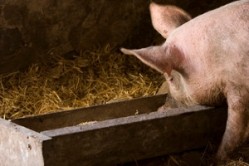'We are building a new frontier' Cargill talks additives and health challenges

Don Giesting, the additives portfolio manager for the Cargill division, told FeedNavigator.com yesterday that the company is continuing to develop its Promote line to support the industry in its migration away from antibiotics.
The new regulatory environment gives the firm an opportunity, he said, to demonstrate the payback that can be generated by the use of feed additives, particularly in terms of bolstering feed gain and conversion rates.
“Producers still have a lot of concerns but, through our work in other markets that have already dealt with this challenge, we can help them navigate growth promoter phase-out.
We have a wide range of tools to draw on, along with a broad knowledge of which additives work best in non-medicated feed and which ones show more efficiency in a medicated one,” said Giesting.
Additives for monogastrics
Acidifiers for example, have been commonly used in Europe to complement or partially replace antibiotics, said the additives portfolio manager.
And he said there has been wide take-up by pig producers of the Promote additive, ProHacid Advance, since its launch around seven months ago. It is a blend of six organic acids for monogastrics designed to promote growth and gut health.
“The formulation for piglet producers in the US is slightly different to the blend used by European and Asian producers in that pigs are weaned earlier in the US and starter diets for pigs in that market still contain antibiotics along with therapeutic levels of zinc and copper,” said Giesting.
He said several trials conducted by Cargill in medicated diets have shown the significant effects of ProHacid Advance on animal performance, translating into an economical benefit of $0.45 per piglet.
“The greatest response in feed conversion and gain rates when using the additive can be seen in the first two weeks after weaning – US piglet producers have recorded an 8% increase in gain rate and a 5% hike in feed conversion in that period,” said Giesting.
Health challenges
He said Cargill continues to focus on research evaluating the mode of action of additives and how they interact with health challenges.
The company has been investing a large percentage of its research dollars into lactylates, he said.
Aloapur, its lactylates-based product for poultry farmers developed in collaboration with Corbion Purac, has had a good reception in Europe and in South Korea since its kick-off last year, said Gilles Houdart, marketing director of additives at Cargill Animal Nutrition.
He told us there has been strong demand from poultry producers in those markets for the gut health promoter in the past few months.
“We are building a new frontier in terms of managing clostridium risk in broilers through lactylates,” said Houdart.
Aloapur, he said, works best under suboptimal circumstances.
Such conditions in poultry farming may result from coccidiosis, dysbacteriosis, necrotic enteritis, coccidiosis vaccination, climatic stress, high stocking density, litter quality problems or diets containing raw materials with low digestibility.
Work on Aloapur was begun by Provimi four years ago. The integration of that company by Cargill helped accelerate the understanding of the mode of action of lactylates, in particular due to improved trial modeling and in vitro analysis, said the company.
Lactylates research
Supporting documentation around Aloapur includes data on a trial testing the use of lactylates in diets for broilers from 0 to 28 days based on corn, soya bean meal and wheat.
The efficiency of lactylates were investigated along with AGPs (Zinc Bacitracin (BMD) and Virginiamycin) and plant extract derived products as well as different mixtures of medium chain fatty acids and essential oils in a model system reproducing sub-optimal conditions.
Lactylates showed similar body weight gain at 28 day of age compared to BMD or Virginiamycin and significantly better body weight gain compared to other products under challenging conditions, said Cargill.
The same trial showed significantly better feed conversion ratio in the Lactylates group when comparing with control group, AGP and competitive products, said the company.



![Feed formulation firm buy underscores Cargill animal nutrition growth strategy [pic: (c) istock.com]](/var/wrbm_gb_food_pharma/storage/images/_aliases/wrbm_medium/publications/feed/feednavigator.com/article/2015/12/17/cargill-buys-uk-feed-formulation-software-firm/746655-2-eng-GB/Cargill-buys-UK-feed-formulation-software-firm.jpg)











